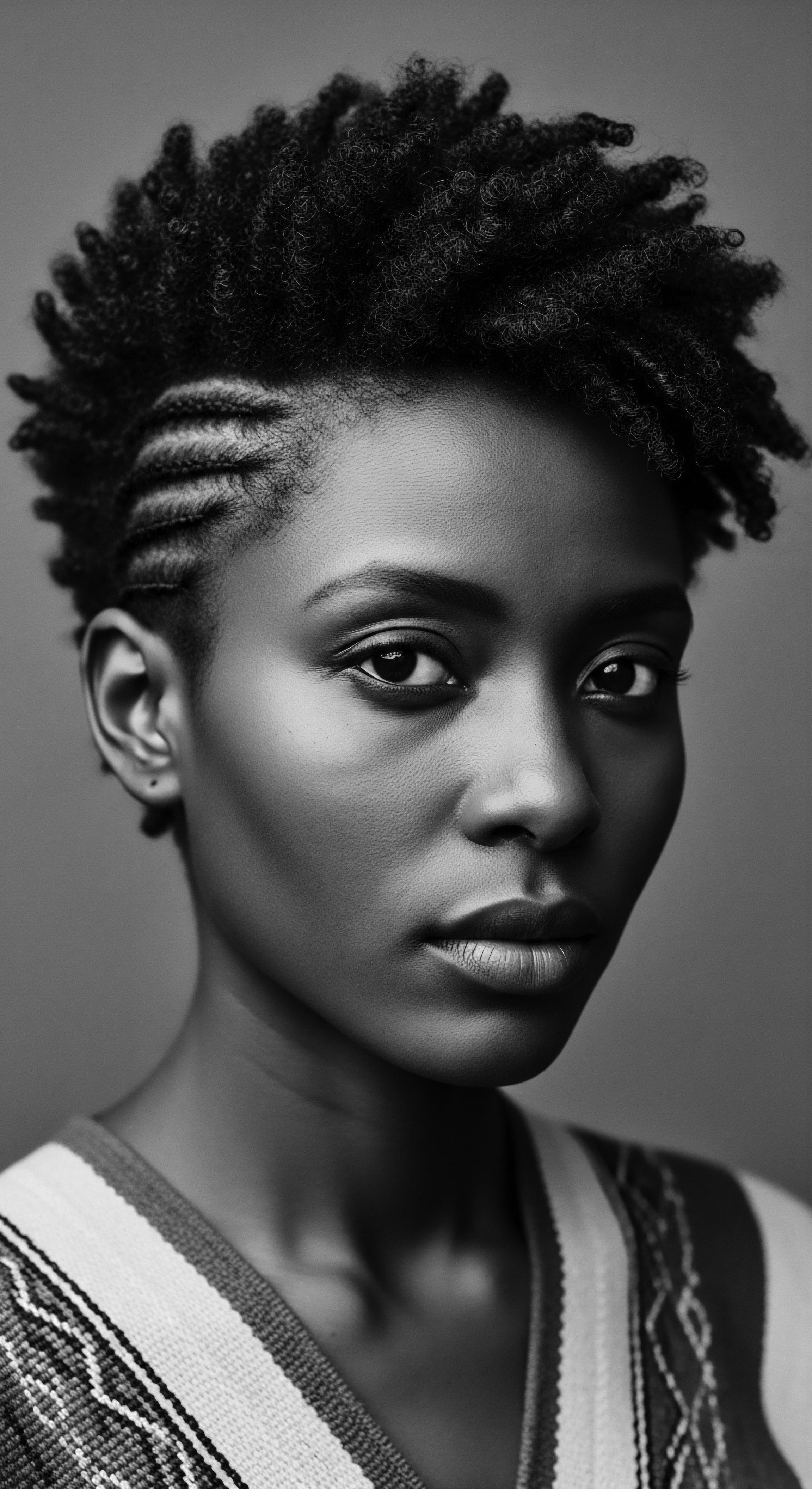
Roots
Consider, for a moment, the individual strand of textured hair. It is not merely a biological filament, but a living testament, a silent keeper of generations, carrying within its very spiral the echoes of ancient winds and the wisdom of hands long past. To truly grasp the story of henna on textured hair, we must first listen to these whispers from the source, seeking the fundamental connections that bind the vibrant botanical world to the very architecture of our coils and kinks. It is a dialogue between elemental chemistry and the enduring legacy of human ingenuity.
The origins of Henna, derived from the plant Lawsonia inermis, stretch back thousands of years across North Africa, the Middle East, and parts of Asia. This humble shrub, with its unassuming green leaves, has colored the rituals and daily lives of countless peoples. Its power comes from Lawsone, the red-orange dye molecule found within its leaves.
When these leaves are crushed and mixed with a liquid, lawsone is released, ready to bind with protein, staining skin, nails, and, critically, hair. For those with textured hair, this connection reaches far beyond surface aesthetics; it is a profound historical link, a continuum of care passed through the ages.
Understanding how henna engaged with textured hair starts with an appreciation for the unique anatomical characteristics of these strands. Unlike straight hair, which typically grows from a round follicle, textured hair often emerges from an Elliptical Follicle, contributing to its distinctive curl pattern. This helical structure, with its unique bends and twists, means varying surface areas and porosities along a single strand.
Ancestral practitioners, without modern microscopes, surely perceived the different ways plant preparations interacted with these diverse textures, observing the deep absorption and lasting color henna offered. Their empirical knowledge, refined over centuries, intuitively understood how the plant’s compounds could protect and color these resilient strands.
Henna’s ancient journey across continents speaks to its enduring appeal as a source of color and care for diverse hair textures.
Beyond its capacity for vibrant color, henna was also valued for its conditioning attributes. Its fine particles could coat the hair shaft, lending a perceived strength and resilience. In arid climates, where textured hair might be particularly susceptible to dryness and environmental stress, henna offered a layer of protection, acting as a natural balm. This dual function, both aesthetic and protective, underscores its widespread adoption within ancient cultures where hair was not only a canvas for adornment but also a vital part of personal and communal identity.
The lexicon surrounding hair care in ancient times, though not always explicitly detailing “textured hair” as a modern category, often spoke to practices applicable to a wide range of hair types prevalent in its regions of origin. Terms related to protective styles, herbal rinses, and scalp treatments were common, suggesting a comprehensive approach to hair wellness that very much aligned with the needs of coily and curly strands. The very act of preparing and applying henna was a knowledge transfer, a teaching of remedies that echoed through families, each generation learning the subtle art of botanical care from the one before.

How Did Ancestral Understanding Guide Early Henna Application?
Ancestral understanding, refined through keen observation and communal practice over millennia, was the guiding principle for early henna application. It was not a haphazard process but a ritualized one, often passed down from elder women to younger generations. This knowledge encompassed not only the proper selection and grinding of the leaves but also the optimal conditions for dye release, the addition of other botanicals for varied shades or conditioning properties, and the nuanced understanding of application techniques that would best serve different hair types and desired outcomes. For textured hair, this meant an intuitive recognition of its unique porosity and curl pattern, allowing for methods that ensured even saturation and maximum benefit.
The earliest applications of henna weren’t merely about personal adornment; they were often tied to significant life events, social status, or spiritual practices. The careful preparation and communal application rituals speak to a reverence for the plant and the transformative power it held, reflecting a deep engagement with the natural world.

Ritual
The application of henna onto hair was, for many ancient communities, far more than a simple cosmetic act; it was a ritual, a tender thread woven into the fabric of daily life, celebration, and spiritual connection. These practices, deeply embedded within the heritage of Black and mixed-race communities across continents, reveal the profound cultural significance of hair care and adornment. We find these threads stretching from the sun-drenched sands of North Africa to the bustling markets of the Indian subcontinent, each culture imbuing the practice with its own unique layers of meaning.
Consider the ancient traditions of Sudan and Nubia, where henna played a central part in beauty and ceremonial rites for millennia. Archaeological findings and historical accounts consistently highlight its extensive use on hair, particularly among women whose hair textures ranged from wavy to tightly coiled. For instance, in ancient Egypt, closely linked to Nubian culture, evidence from tomb paintings and mummified remains indicates henna was a favored cosmetic. The mummified remains of individuals, including those with hair exhibiting distinct curl patterns, show traces of henna application.
Dr. Joann Fletcher, a noted Egyptologist, has discussed how henna was used for hair conditioning and coloring, often found on the hair of mummies, indicating its widespread application across social strata and hair types (Fletcher, 2017). This specific historical example powerfully illuminates henna’s connection to textured hair heritage, predating many modern categorizations, yet undeniably serving those with naturally curly and coily strands.
The communal act of applying henna forged bonds, transforming individual beauty practices into shared cultural experiences.
In North African and Middle Eastern communities, henna was, and still is, a cornerstone of bridal ceremonies, childbirth celebrations, and other rites of passage. The application to hair, alongside skin, often involved entire female lineages, with grandmothers, mothers, and aunts gathering to prepare the paste and apply it with care. This communal aspect solidified bonds, making the practice a shared experience of cultural knowledge transfer and affectionate grooming. For hair that was often styled in intricate braids, twists, or left free in its natural glory, henna offered both a rich hue and a beloved conditioning treatment, seen as a blessing for health and fertility.

What Community Practices Surrounded Ancient Henna Use?
Ancient henna use was often steeped in community and intergenerational knowledge. The gathering of leaves, their meticulous drying and grinding into a fine powder, and the mixing with specific liquids (like tea, water, or citrus juices) to achieve the perfect consistency and dye release were all carefully managed processes, sometimes accompanied by songs, stories, and shared meals.
- Bridal Rites ❉ In many cultures, a “henna night” (Laylat al-Henna) was a celebratory pre-wedding event where the bride, her female relatives, and friends would gather. Henna was applied not only to her hands and feet but also to her hair, symbolizing good fortune, beauty, and blessing for the new union.
- Childbirth Celebrations ❉ After the birth of a child, particularly a firstborn, henna was sometimes applied to the mother’s hair as part of a purification and beautification ritual, believed to restore strength and vibrancy.
- Festivals and Holy Days ❉ During religious festivals like Eid or cultural celebrations, individuals would adorn themselves with henna, including on their hair, as a sign of festivity and joy. This practice was common across various communities, including those with diverse hair textures.
- Ancestral Teachings ❉ The precise techniques for mixing and applying henna, tailored for different hair types and desired outcomes, were not learned from books but from observation and direct instruction within the family and community. This ensured the continuity of knowledge regarding this precious botanical.
Beyond these formal rituals, henna was also incorporated into daily hair care for many, serving as a natural dye that enhanced the depth and brilliance of darker strands, while simultaneously lending a protective layer against environmental elements. The tradition of using botanicals for hair nourishment and aesthetic appeal is a thread that runs deep within the heritage of textured hair care.
| Region/Community Ancient Egypt & Nubia |
| Traditional Application Hair coloring and conditioning, sometimes for mummified remains. |
| Cultural Significance Beauty, preservation, ritual purification, social status. |
| Region/Community North Africa (e.g. Morocco, Algeria) |
| Traditional Application Bridal rites, postpartum care, daily hair treatments. |
| Cultural Significance Celebration, blessing, protection, communal bonding. |
| Region/Community South Asia (e.g. India, Pakistan) |
| Traditional Application Bridal ceremonies, religious festivals, herbal hair conditioning. |
| Cultural Significance Auspiciousness, beauty, cooling properties, hair health. |
| Region/Community These practices illuminate henna's enduring place in textured hair heritage, reflecting both practical care and deep symbolic meaning. |

Relay
The journey of henna, from ancient desert shrub to a cherished element in global hair care, represents a remarkable relay of knowledge, practice, and identity across generations and geographical boundaries. This transmission is particularly evident within the heritage of textured hair, where traditional wisdom regarding botanicals has been carefully guarded and adapted, even as external forces sought to diminish its power. The continued presence of henna today, often championed by communities reclaiming their ancestral beauty practices, speaks to a resilience ingrained in both the plant and the people who have used it.
The scientific validation of what ancient peoples intuitively understood about henna provides a compelling narrative. The lawsone molecule, a naphthoquinone, binds directly to the Keratin protein in hair. This chemical interaction is what gives henna its staining power and, crucially, its conditioning effects. For textured hair, which can sometimes be more susceptible to structural damage or moisture loss due to its coil and curl patterns, the protective coating offered by lawsone is particularly beneficial.
It can smooth the cuticle, reducing frizz and adding a perceptible sheen, effects observed and appreciated for millennia. The knowledge of this interaction, while not articulated in molecular terms by ancestors, was nevertheless practically applied, leading to generations of vibrant, strong hair.
Historically, henna’s role in textured hair communities also became a subtle form of resistance and cultural preservation. In contexts where dominant beauty standards sought to impose a singular aesthetic, traditional hair practices, including the use of plant-based dyes and treatments, became a quiet defiance. They were a means of holding onto a distinctive identity, a connection to a homeland, and an assertion of inherent beauty.
For Black and mixed-race individuals displaced through migration or forced relocation, maintaining hair rituals like henna application often served as a tangible link to ancestral lands and the collective memory of their people. This ongoing tradition allowed for an expression of continuity, a bridge between past and present.
From ancient wisdom to modern validation, henna’s role in textured hair care has been a continuous cultural and scientific conversation.
Today, the re-emergence of henna within natural hair movements is a powerful example of this cultural relay. Many individuals with textured hair are consciously turning away from synthetic dyes and harsh chemical treatments, seeking alternatives rooted in natural principles and historical efficacy. They find in henna not just a coloring agent, but a holistic approach to hair care that aligns with a deeper connection to ancestral wellness and sustainable living. This contemporary practice is a direct descendant of the ancient rituals, yet it is also a re-interpretation, informed by modern understanding but still honoring the wisdom of the past.

Can Modern Science Validate Ancestral Henna Wisdom?
Yes, modern science does indeed validate much of the ancestral wisdom surrounding henna. What was once observed through centuries of empirical practice can now be explained at a molecular level.
- Protein Binding ❉ Scientific studies confirm that lawsone molecules in henna form a strong bond with the keratin protein in the hair shaft. This binding strengthens the hair, adding a protective layer and reducing protein loss, which is particularly advantageous for the delicate structures of textured hair. (Dixit & Sharma, 2011)
- Conditioning Effects ❉ Research shows that henna can help seal the hair cuticle, leading to reduced porosity and increased shine. This aligns with ancestral observations of henna leaving hair feeling stronger, smoother, and more radiant.
- Antifungal and Antibacterial Properties ❉ Traditional uses of henna often included treating scalp conditions. Modern studies have identified antimicrobial properties in Lawsonia inermis, supporting its historical use in maintaining scalp health. (Ali & Al-Ezzi, 2013)
- UV Protection ❉ Some studies suggest that the coating created by henna on the hair can offer a degree of protection against UV radiation, further validating its use in sun-drenched regions.
This interplay of ancient observation and modern scientific corroboration underscores the profound depth of ancestral knowledge, demonstrating that generations before us possessed an astute understanding of nature’s remedies. The enduring presence of henna in textured hair care is a vibrant testament to this legacy.

Reflection
Our exploration of henna’s enduring legacy on textured hair reveals more than a mere historical curiosity; it presents a living, breathing archive of ancestral wisdom, resilience, and beauty. Each coiled or kinky strand, kissed by the earth’s bounty, continues to carry the memory of hands that nurtured it, of rituals that honored it, and of identities that were both expressed and protected through its adornment. The journey of henna, from ancient ceremonial adornment to a contemporary staple, is deeply intertwined with the multifaceted heritage of Black and mixed-race communities globally. It reminds us that care for our strands is often, at its heart, a profound act of self-reverence and a continuity with those who came before us.
The thread connecting generations through the application of a plant-derived dye is a testament to the ingenuity and deep connection to nature that characterized ancestral hair traditions. This is the very Soul of a Strand ❉ not just the physical fiber, but the stories it holds, the wisdom it conveys, and the unbroken chain of heritage it represents. Henna, in this context, serves as a powerful symbol of this living legacy, a vibrant reminder that our past continues to color our present, guiding us towards a future where textured hair is universally celebrated for its innate glory and its rich, unparalleled history.

References
- Fletcher, Joann. (2017). The Story of Egypt ❉ The Civilization that Shaped the World. Pegasus Books.
- Dixit, N. & Sharma, V. (2011). Hair Care and Styling Formulations. McGraw Hill Professional.
- Ali, M. A. & Al-Ezzi, A. A. (2013). Antifungal Activity of Lawsonia inermis (Henna) Extract Against Some Pathogenic Fungi. Journal of Pure & Applied Sciences, 25(1), 1-5.
- Mann, J. (1994). Hair ❉ A Cultural History. Bulfinch Press.
- Blunt, A. (2007). Cultural Geographies of Hair. Ashgate Publishing.
- Spring, C. (2009). African Textiles Today. British Museum Press.
- Daly, M. (2015). Black Hair ❉ Art, Style, and Culture. Rizzoli International Publications.
- Goodman, R. (2008). The Chemistry of Cosmetics. Royal Society of Chemistry.
